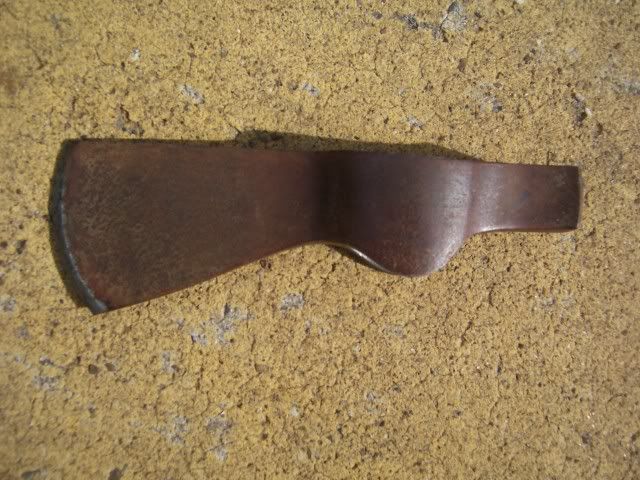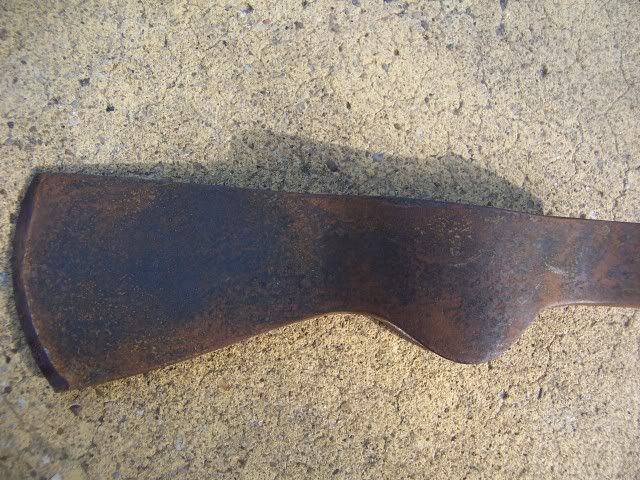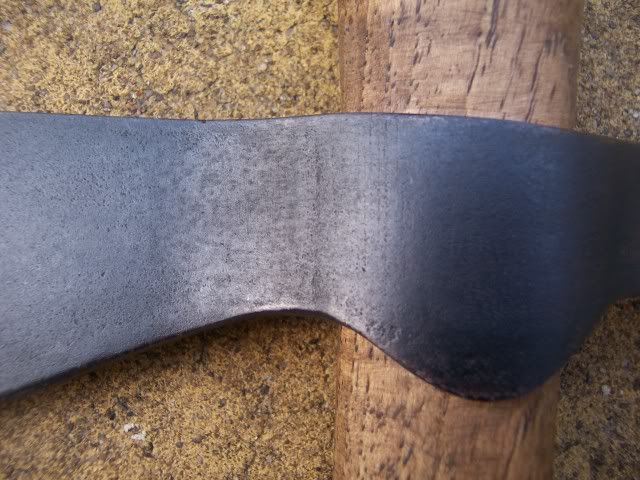A Tutorial for Rust Bluing
Aug 3, 2013 10:15:20 GMT
Post by Jack Loomes on Aug 3, 2013 10:15:20 GMT
By Sophilos of www.bushcraftusa.com
This method is still in it's infancy, and I am still working on the finer details, but I'll try to make this as comprehensive as possible.
So, here we go...
Materials needed
For the rusting:
3% Hydrogen Peroxide (the usual kind)
Table salt
For the bluing:
Distilled water
Accessories:
Pot large enough to accommodate the object you are going to rust
(do NOT use aluminum; stainless still is fine, but will rust heavily. Non-stick pans seem to be unaffected by the process, but your experience may vary)
Toothbrush (for scrubbing and polishing)
Tongs (for moving and manipulating the item being rusted)
Gloves (For keeping your greasy fingers off the steel- I use cotton)
Oil for finishing-Boiled linseed works great (do NOT use WD-40 or any other anti-rust oil! )
The process
Prep the steel:
Before you begin to oxidize the steel, you must first remove all traces of paint, dirt, oil or coatings of any kind. Use acetone or alcohol to degrease the steel, and use your gloves when handling the object from this point on. The oils from your hands can cause an uneven corrosion, and fingerprints can even become permanently imprinted in the bluing process.
*note* If you wish to preserve the edge on your blade and don't want it to rust, you can use fingernail polish to paint over the edge. Use a few coats, as a little of this may be removed in the boiling process.
Method 1 - Browning the Steel
Step 1. In a pot that you don't mind destroying, pour in enough peroxide that will fully cover the object to be worked. If rusting an axe, keep in mind that you will have to maneuver the head into a variety of positions to ensure even oxidation.
Next, heat the peroxide over the burner to just under boiling temperature. A little under or a little over is no big deal; you just want the liquid hot, this part is no exact science.
Once the peroxide is hot, start mixing in the salt. This may take a lot salt, just keep mixing it in until no more will dissolve into the liquid. You will know when enough is enough, as the salt will begin accumulating at the bottom of the pan. When this happens, the solution is ready.
While the liquid is still hot, remove it from the burner and gently place in the steel with a pair of tongs. The peroxide/salt mixture will immediately begin reacting with the metal, and it will begin rusting right before your eyes.
The length of time you need to leave it in depends on the steel, and on the size of the object being worked. Leave it in for just a minute at first, and then remove with the tongs and check to see how the rusting is coming along. It should look something like this:

Once the steel is almost completely covered in rust, rinse it off in water and then dry thoroughly with a towel or napkin.
Using a toothbrush, very gently start brushing away the loose rust; it should come off fairly easily. What you are doing here is evening out the layer of corrosion and making the surface smooth. There should be rusty areas that don't rub off with the brush, this is good.
At this stage, the finish may look like shit; It may appear splotchy and uneven, and some areas may still appear to be bare metal; this is to be expected and is not a problem.
Step 2. Step 2 is a repeat of Step 1. Now, place the object back in the peroxide bath for a second dip. If the peroxide/salt mixture is still hot, it can be used again for the second bath; you can reheat it as necessary. Place in the object once again and let it begin to rust. This time it may react more slowly.
Continue the repeat of Step 1: Remove object from solution, rinse under water, dry, use toothbrush until surface is smooth and even.
Continue this entire process until you have a nice, smooth, even layer that doesn't rub off. This make take a few cycles; it all depends on your steel and the size of the object.
Once you are satisfied with the finish, you have successfully 'browned' your blade and can choose to stop here if you wish. Just rub some oil into the finish and your done.
If you wish to 'blue' the steel, then move on to the next step.
Method 2-Bluing the Steel
For this next step, you are basically going to boil your object in distilled water until the rust is converted into another type of oxide, and becomes black.
In a pot (this one will not get damaged by the process), pour in enough distilled water to cover the object to be blued. You will want to keep the object from touching the bottom of the pan, so you will have to rest it on something, or suspend it with wire or string. I like to simply put a few medium sized rocks or even a brick in the bottom of the pot, and place the object on top.
Once your object is set up, bring the water to a rolling boil and boil the object for about 10 minutes. Don't worry, the steel will only get as hot as the boiling water, and this will not affect the heat-treat in any manner.
After about 10 minutes, depending on the size of the object, all, or most of the red rust should have turned black. You may have to flip the object into different positions during the boiling process so that the finish comes out even.
This is what the steel looks like as it begins to change:

After this process is repeated a few times, you should end up with a finish like this:

Once this method is complete, you can go back to the peroxide oxidation process once again and repeat the entire process. This will build up several layers of oxidation and will ensure an even, sturdy coating. You can of course stop here; it all depends on the finish your trying to obtain.
Well, that's pretty much it. I welcome any questions or input on the methods described here. Hope this helps.
Source: bushcraftusa.com/forum/showthread.php/16456-Rust-bluing-A-tutorial
*Editor's Note: I'd strongly consider whether you want to include salt in the recipe or not. The steel will rust without salt, and salt has a nasty habit of burying itself in steel and causing rusting in future which will be impossible to stop without sanding the finish off. The salt will penetrate below the finish and require substantially resurfacing to remove.
Happy Bluing!
This method is still in it's infancy, and I am still working on the finer details, but I'll try to make this as comprehensive as possible.
So, here we go...
Materials needed
For the rusting:
3% Hydrogen Peroxide (the usual kind)
Table salt
For the bluing:
Distilled water
Accessories:
Pot large enough to accommodate the object you are going to rust
(do NOT use aluminum; stainless still is fine, but will rust heavily. Non-stick pans seem to be unaffected by the process, but your experience may vary)
Toothbrush (for scrubbing and polishing)
Tongs (for moving and manipulating the item being rusted)
Gloves (For keeping your greasy fingers off the steel- I use cotton)
Oil for finishing-Boiled linseed works great (do NOT use WD-40 or any other anti-rust oil! )
The process
Prep the steel:
Before you begin to oxidize the steel, you must first remove all traces of paint, dirt, oil or coatings of any kind. Use acetone or alcohol to degrease the steel, and use your gloves when handling the object from this point on. The oils from your hands can cause an uneven corrosion, and fingerprints can even become permanently imprinted in the bluing process.
*note* If you wish to preserve the edge on your blade and don't want it to rust, you can use fingernail polish to paint over the edge. Use a few coats, as a little of this may be removed in the boiling process.
Method 1 - Browning the Steel
Step 1. In a pot that you don't mind destroying, pour in enough peroxide that will fully cover the object to be worked. If rusting an axe, keep in mind that you will have to maneuver the head into a variety of positions to ensure even oxidation.
Next, heat the peroxide over the burner to just under boiling temperature. A little under or a little over is no big deal; you just want the liquid hot, this part is no exact science.
Once the peroxide is hot, start mixing in the salt. This may take a lot salt, just keep mixing it in until no more will dissolve into the liquid. You will know when enough is enough, as the salt will begin accumulating at the bottom of the pan. When this happens, the solution is ready.
While the liquid is still hot, remove it from the burner and gently place in the steel with a pair of tongs. The peroxide/salt mixture will immediately begin reacting with the metal, and it will begin rusting right before your eyes.
The length of time you need to leave it in depends on the steel, and on the size of the object being worked. Leave it in for just a minute at first, and then remove with the tongs and check to see how the rusting is coming along. It should look something like this:

Once the steel is almost completely covered in rust, rinse it off in water and then dry thoroughly with a towel or napkin.
Using a toothbrush, very gently start brushing away the loose rust; it should come off fairly easily. What you are doing here is evening out the layer of corrosion and making the surface smooth. There should be rusty areas that don't rub off with the brush, this is good.
At this stage, the finish may look like shit; It may appear splotchy and uneven, and some areas may still appear to be bare metal; this is to be expected and is not a problem.
Step 2. Step 2 is a repeat of Step 1. Now, place the object back in the peroxide bath for a second dip. If the peroxide/salt mixture is still hot, it can be used again for the second bath; you can reheat it as necessary. Place in the object once again and let it begin to rust. This time it may react more slowly.
Continue the repeat of Step 1: Remove object from solution, rinse under water, dry, use toothbrush until surface is smooth and even.
Continue this entire process until you have a nice, smooth, even layer that doesn't rub off. This make take a few cycles; it all depends on your steel and the size of the object.
Once you are satisfied with the finish, you have successfully 'browned' your blade and can choose to stop here if you wish. Just rub some oil into the finish and your done.
If you wish to 'blue' the steel, then move on to the next step.
Method 2-Bluing the Steel
For this next step, you are basically going to boil your object in distilled water until the rust is converted into another type of oxide, and becomes black.
In a pot (this one will not get damaged by the process), pour in enough distilled water to cover the object to be blued. You will want to keep the object from touching the bottom of the pan, so you will have to rest it on something, or suspend it with wire or string. I like to simply put a few medium sized rocks or even a brick in the bottom of the pot, and place the object on top.
Once your object is set up, bring the water to a rolling boil and boil the object for about 10 minutes. Don't worry, the steel will only get as hot as the boiling water, and this will not affect the heat-treat in any manner.
After about 10 minutes, depending on the size of the object, all, or most of the red rust should have turned black. You may have to flip the object into different positions during the boiling process so that the finish comes out even.
This is what the steel looks like as it begins to change:

After this process is repeated a few times, you should end up with a finish like this:

Once this method is complete, you can go back to the peroxide oxidation process once again and repeat the entire process. This will build up several layers of oxidation and will ensure an even, sturdy coating. You can of course stop here; it all depends on the finish your trying to obtain.
Well, that's pretty much it. I welcome any questions or input on the methods described here. Hope this helps.
Source: bushcraftusa.com/forum/showthread.php/16456-Rust-bluing-A-tutorial
*Editor's Note: I'd strongly consider whether you want to include salt in the recipe or not. The steel will rust without salt, and salt has a nasty habit of burying itself in steel and causing rusting in future which will be impossible to stop without sanding the finish off. The salt will penetrate below the finish and require substantially resurfacing to remove.
Happy Bluing!

.png?width=1920&height=1080&fit=bounds)